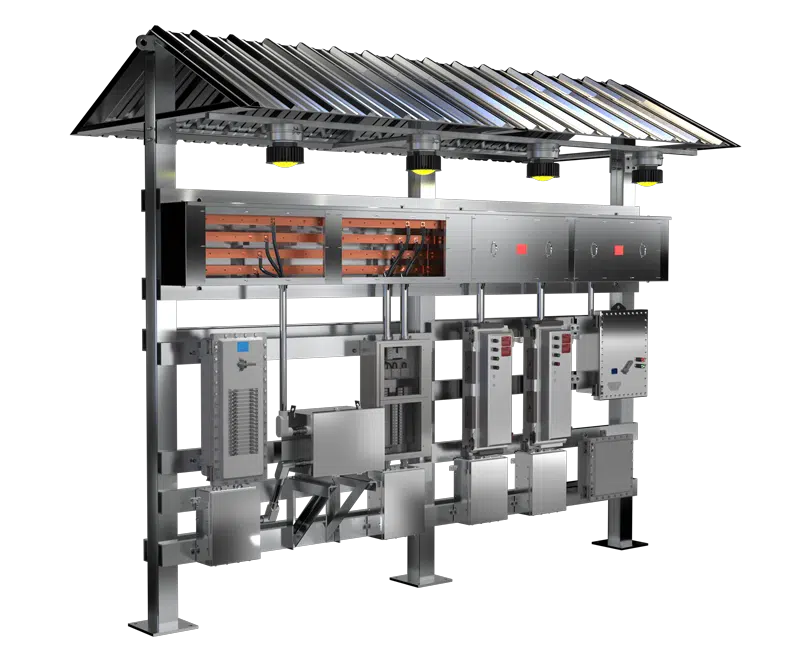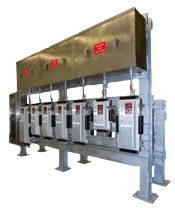
In the hazardous location (HazLoc) market, we’ve seen a troubling shift away from the foundational engineering standards that once defined our industry. Ten to fifteen years ago, industry leader Crouse-Hinds actively educated engineers, EPCs, and end-users about critical IEEE and UL specifications for switchrack assemblies. Today, however, a race to cut corners has resulted in non-compliant solutions flooding the market, creating confusion and posing serious safety risks. It’s time to revisit the forgotten standards and reassert the importance of properly designed switchracks.
A Lost Art in Compliance
Switchracks are essential assemblies in the petrochemical and industrial sectors, providing centralized control and distribution points for electrical loads in hazardous environments. Properly engineered switchracks adhere closely to standards such as IEEE and UL, ensuring equipment performance, reliability, and—most importantly—safety. But the modern market has drifted. Many EPCs and end-users are unaware that not every assembly labeled as a “switchrack” meets these critical engineering requirements.
Historically, switchrack compliance wasn’t optional. Crouse-Hinds took pride in advocating stringent IEEE and UL standards because doing so protected their clients and their investments. This adherence not only prevented costly downtime but also significantly enhanced worker safety by mitigating risks associated with electrical faults, explosive gases, and structural failures.
The Consequences of Non-Compliance
The consequences of the shift toward non-compliance have been costly. We’ve witnessed OEMs and small contractors enter the market with unlisted and poorly engineered switchrack solutions. These setups often bypass essential structural engineering calculations, overlook adequate bus duct bracing, and fail to properly address grounding and fault-clearance methods.
The result? Equipment failures, unscheduled outages, costly retrofits, and even catastrophic safety incidents. Switchracks built without IEEE and UL compliance can easily lead to arc flashes, inadequate explosion-proofing, and structural collapses—each posing unacceptable risks in hazardous locations.
What Makes a Compliant Switchrack?
Returning to compliant practices involves understanding the baseline criteria clearly outlined by IEEE and UL standards. An engineered switchrack must consider:
- Structural Integrity: Compliance requires detailed structural analyses accounting for seismic zones and wind loading. Proper vertical supports (I-beams) and horizontal supports (C-channels), either galvanized steel or aluminum, are essential.
- Bus Duct Design: Bus ducts must be robust enough to withstand short-circuit forces. Material selection, copper bus plating, insulation, and bracing ratings must all adhere to calculated electrical loads and fault-current scenarios.
- Area Classification: Clearly defined as Class I, Division 1 or Division 2, proper categorization determines the required protective measures, from explosion-proof enclosures to the use of special conduit seals and entries.
- Detailed Testing and Commissioning: IEEE and UL standards necessitate comprehensive factory and field testing, including insulation resistance checks, torque verification, grounding system tests, and functional validation of protective devices and motor starters.
- Maintenance Protocols: Compliant designs include clear maintenance instructions, ensuring regular inspections for corrosion, mechanical integrity, and electrical reliability over the equipment’s lifetime.
Economic Justifications for Compliance
Beyond safety, there’s a strong economic case for returning to rigorous compliance. While initial investment costs for compliant switchracks might appear higher, the long-term savings from reduced maintenance, minimized downtime, and prevented incidents are substantial. Consider a facility operating in a petrochemical environment: downtime due to a single non-compliant incident can easily reach millions of dollars per day. Moreover, insurance premiums and liability risks increase dramatically when installations deviate from recognized standards.
Properly engineered switchracks significantly cut installation times compared to traditional substations. Modular substations and block-built structures involve extensive on-site construction, leading to prolonged project timelines, higher labor costs, and greater risk of project overruns. Conversely, IEEE and UL-compliant switchracks arrive pre-tested and ready for immediate installation, drastically reducing lead times and improving overall project economics.
How Industry Leaders Can Reclaim Compliance
It’s not too late to rectify the industry’s drift from standards. Industry leaders, particularly Crouse-Hinds, alongside reputable OEMs like Spike Electric, must spearhead a renewed education and advocacy initiative.
- Technical Education: Proactively educating engineers, EPCs, and end-users through webinars, workshops, white papers, and direct consultations.
- Market Awareness: Promoting awareness of the risks and costs associated with non-compliant equipment installations, emphasizing real-world examples of compliance versus non-compliance outcomes.
- Collaboration: Crouse-Hinds should partner closely with reputable OEMs committed to standards compliance. This ensures consistency in messaging and unified advocacy to procurement and engineering stakeholders.
- Proactive Standards Enforcement: Encourage EPCs and procurement teams to mandate IEEE and UL compliance as non-negotiable line items in project specifications, thus driving accountability through the entire supply chain.
Conclusion: Restoring Integrity to the HazLoc Market
Reclaiming the HazLoc market means embracing the foundational standards that built our industry. IEEE and UL standards exist precisely to ensure safety, reliability, and efficiency. As professionals and industry leaders, our collective responsibility is to reinforce these standards, protecting our clients, employees, and reputation.
The technology and expertise already exist. What remains is our resolve to advocate for standards compliance, ensuring the HazLoc market regains its footing. Only then can we guarantee safer, more reliable, and economically beneficial outcomes for all stakeholders involved.
Electrical Safety and Protection
Ensuring electrical safety is paramount in HazLoc designs. IEEE standards detail the essential role of protective devices such as circuit breakers, overload relays, and proper grounding methods. Fault conditions in hazardous environments present significant safety hazards, making properly engineered protective measures indispensable.
Spike Electric rigorously applies these safety guidelines, integrating robust circuit protection, precise grounding systems, and advanced arc-flash mitigation techniques. Each protective device is carefully coordinated and tested in factory acceptance tests, ensuring switchracks provide the highest levels of operational safety and protection.
Maintenance and Inspection Accessibility
Designing for maintainability is crucial, especially in hazardous locations. IEEE emphasizes that compliant switchracks must facilitate regular maintenance inspections, corrosion assessments, and electrical integrity tests without compromising safety or requiring shutdowns.
Spike Electric integrates these considerations into every switchrack design, featuring open and accessible layouts, corrosion-resistant components, and clear maintenance procedures. This approach enhances ease of inspection, extends operational life, and significantly reduces downtime associated with routine maintenance.
Practical Advantages of Compliant Design
Designing HazLoc switchracks according to IEEE and UL standards delivers tangible operational and economic benefits. Facilities realize reduced installation times, streamlined commissioning, and enhanced reliability compared to conventional substations or modular installations.
Spike Electric Controls exemplifies these advantages through its turnkey solutions. Switchracks arrive fully assembled, pre-tested, and ready for immediate installation, significantly accelerating project timelines and minimizing costly field labor. The long-term operational benefits, including minimized downtime, reduced maintenance costs, and increased reliability, provide substantial return on investment.
Spike Electric’s Commitment to Engineering Excellence
With years of experience delivering compliant HazLoc switchrack solutions, Spike Electric Controls embodies the best practices outlined by IEEE. Their expert engineering teams precisely interpret client specifications, ensuring every project aligns with the highest safety and operational standards. From meticulous structural design to detailed electrical integration and rigorous safety testing, Spike Electric delivers switchracks that exceed regulatory requirements and client expectations.
Conclusion: Essential Guidelines for Every Engineer
Designing switchracks for Class I, Div 1 & Div 2 environments requires comprehensive understanding and adherence to IEEE standards, combined with practical insights from experienced industry leaders like Spike Electric Controls. By focusing on structural integrity, detailed electrical engineering, rigorous safety measures, and maintainability, engineers can ensure their designs provide exceptional reliability, safety, and economic efficiency.
For engineers working within hazardous locations, adopting these principles isn’t merely advisable—it’s essential. With a clear understanding of classification requirements, structural needs, and electrical compliance, engineers can confidently deliver solutions that not only meet regulatory expectations but also protect lives, investments, and operational continuity.


